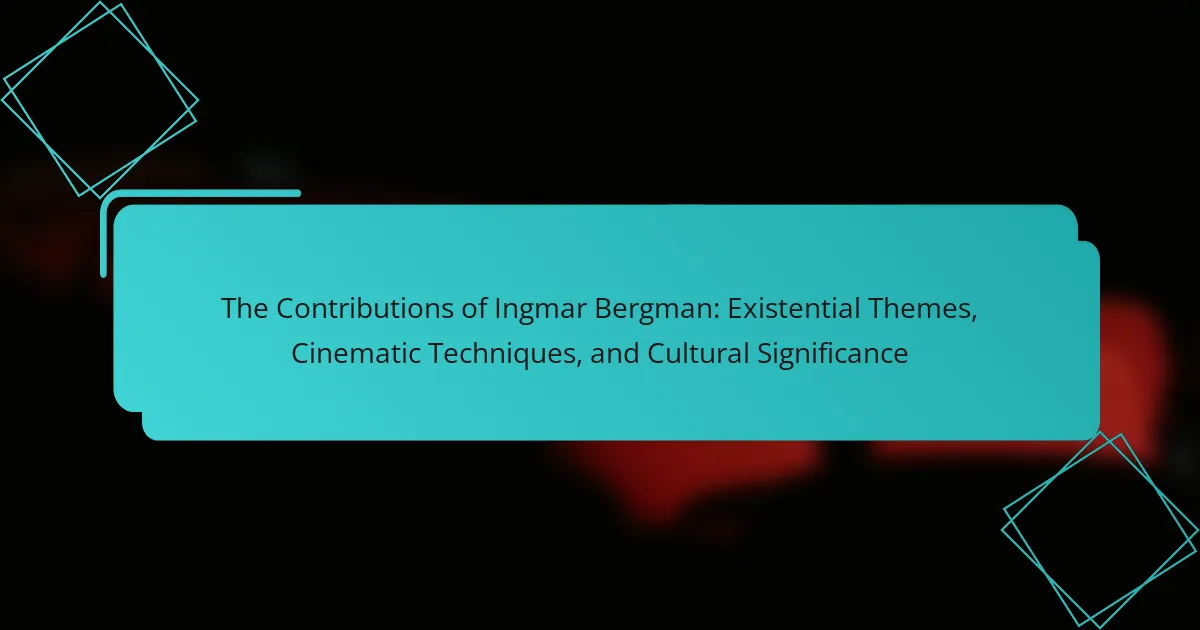Ingmar Bergman is a pivotal figure in cinema, known for his exploration of existential themes and innovative cinematic techniques. His films, particularly “The Seventh Seal,” address profound questions surrounding faith, death, and isolation, becoming cultural touchstones that resonate with audiences. Bergman’s distinctive use of close-ups and minimalist settings enhances emotional intensity and character development, influencing filmmakers and shaping modern storytelling. His legacy is marked by numerous accolades, including three Academy Awards for Best Foreign Language Film, and continues to inspire discussions on the human condition and societal concerns.

What are the key contributions of Ingmar Bergman to cinema?
Ingmar Bergman significantly contributed to cinema through his exploration of existential themes and innovative cinematic techniques. He delved into the human condition, addressing topics like faith, death, and isolation. His film “The Seventh Seal” famously depicts a knight playing chess with Death, symbolizing the struggle for meaning. Bergman’s use of close-ups heightened emotional intensity and showcased actors’ performances. He often employed minimalistic settings, focusing on character interactions and psychological depth. His narrative style influenced filmmakers worldwide, shaping modern storytelling. Bergman’s work garnered numerous awards, including three Academy Awards for Best Foreign Language Film. His legacy endures, inspiring generations of filmmakers and audiences alike.
How did Bergman’s existential themes shape his films?
Bergman’s existential themes profoundly shaped his films by exploring the human condition and the search for meaning. His narratives often depict characters grappling with isolation, despair, and the quest for identity. This focus on existential dilemmas is evident in films like “The Seventh Seal,” where a knight confronts Death, symbolizing humanity’s struggle with mortality. The use of stark imagery and minimalist settings enhances the emotional weight of these themes. Bergman’s characters frequently engage in deep philosophical dialogues, reflecting his interest in existential philosophy. This dialogue-driven approach invites viewers to contemplate their own existence. Overall, Bergman’s films serve as a medium for exploring complex existential questions, making them resonate with audiences on a profound level.
What specific existential questions does Bergman explore in his works?
Ingmar Bergman explores several specific existential questions in his works. He frequently examines the meaning of life and the search for purpose. Bergman delves into themes of death and the human condition. He questions the existence of God and the nature of faith. The struggle for identity and the essence of personal relationships are also central to his narratives. His films often depict isolation and the quest for connection. Bergman’s characters grapple with despair and the search for redemption. These existential inquiries reflect broader philosophical concerns, making his works profoundly impactful.
How do Bergman’s characters reflect existential dilemmas?
Bergman’s characters reflect existential dilemmas through their profound struggles with meaning and identity. They often confront themes of death, isolation, and the search for purpose. For example, in “The Seventh Seal,” the knight wrestles with the existence of God amid the plague. His interactions with Death personify the human fear of mortality. Similarly, in “Wild Strawberries,” the protagonist grapples with regret and the passage of time. This introspection highlights the search for personal redemption. Bergman’s use of stark visuals and minimal dialogue amplifies these internal conflicts. The characters’ emotional depth resonates with audiences, prompting reflection on their own lives. Through these portrayals, Bergman effectively captures the essence of existential thought.
What cinematic techniques are distinctive in Bergman’s films?
Ingmar Bergman’s films are distinctive for their use of close-ups, symbolic imagery, and stark lighting. Close-ups in his films emphasize emotional intensity and character psychology. This technique creates an intimate connection between the audience and the characters. Symbolic imagery often conveys deeper existential themes. For example, the recurring motif of chess in “The Seventh Seal” represents the struggle between life and death. Stark lighting enhances the mood and highlights the emotional states of characters. Bergman frequently used natural light to create a sense of realism. His innovative use of mise-en-scène allows for a powerful visual storytelling experience. These techniques contribute to the profound impact of his narratives.
How does Bergman utilize lighting and shadow in his storytelling?
Bergman utilizes lighting and shadow to enhance emotional depth and create atmosphere in his storytelling. He often employs stark contrasts between light and dark to symbolize internal conflicts and existential dilemmas. For instance, in films like “The Seventh Seal,” the use of shadows evokes themes of death and uncertainty. The interplay of light and shadow also highlights character emotions, revealing their psychological states. In “Persona,” close-ups with dramatic lighting emphasize the characters’ identities and their struggles. Bergman’s deliberate lighting choices guide audience perception and interpretation of narrative themes. His techniques have influenced cinematic language, establishing a visual style that resonates with viewers.
What role does symbolism play in Bergman’s cinematic style?
Symbolism plays a crucial role in Bergman’s cinematic style. It serves as a means to convey complex emotional and philosophical themes. Bergman often utilizes visual metaphors to represent internal struggles. For instance, the recurring motif of light and darkness symbolizes the duality of human existence. His films frequently feature religious imagery to explore existential questions. The use of objects, such as the chess game in “The Seventh Seal,” symbolizes mortality and the search for meaning. Bergman’s characters often engage in symbolic actions that reflect their inner turmoil. This approach enhances the emotional depth and resonance of his narratives. Overall, symbolism is integral to understanding the psychological and existential layers in Bergman’s work.
In what ways has Bergman’s work influenced contemporary cinema?
Ingmar Bergman’s work has significantly influenced contemporary cinema through his exploration of existential themes and innovative cinematic techniques. His films often delve into complex human emotions and moral dilemmas, which resonate with modern filmmakers. Bergman’s use of close-ups and stark lighting has shaped visual storytelling, impacting cinematography styles today. His narrative structures, often nonlinear and introspective, have inspired filmmakers to experiment with storytelling forms. The psychological depth in his characters has encouraged contemporary writers to develop more nuanced and flawed protagonists. Additionally, Bergman’s focus on the human condition has paved the way for films that tackle philosophical questions in a relatable manner. His legacy is evident in the works of directors like Woody Allen and Lars von Trier, who cite him as a major influence.
How have modern filmmakers drawn inspiration from Bergman’s themes?
Modern filmmakers have drawn inspiration from Bergman’s themes by exploring existential questions and human relationships. His focus on inner turmoil and moral dilemmas resonates in contemporary narratives. Films like “Black Swan” and “The Seventh Seal” share a preoccupation with the human condition. Directors such as Darren Aronofsky and Lars von Trier cite Bergman’s influence on their storytelling. These filmmakers adopt Bergman’s introspective style and psychological depth. They often employ stark visuals and minimal dialogue, reminiscent of Bergman’s techniques. This connection highlights Bergman’s lasting impact on cinematic storytelling. His exploration of faith, despair, and identity continues to inspire new generations of filmmakers.
What are the lasting impacts of Bergman’s techniques on film today?
Bergman’s techniques have profoundly influenced contemporary cinema. His use of close-ups emphasizes emotional depth, shaping character-driven narratives. The exploration of existential themes has become a staple in modern storytelling. Filmmakers like Woody Allen and Lars von Trier cite Bergman as a key inspiration. His innovative use of lighting and shadow has set standards for visual storytelling. Techniques such as dream sequences and non-linear narratives are now widely adopted. Bergman’s focus on human psychology has led to more complex character development in films today. Overall, his legacy continues to resonate in the works of filmmakers worldwide.

How do Bergman’s films reflect cultural significance?
Bergman’s films reflect cultural significance through their exploration of existential themes and human psychology. His works often delve into profound questions of faith, identity, and mortality. For instance, “The Seventh Seal” confronts the inevitability of death and the search for meaning. This film became a cultural touchstone, symbolizing the post-war existential crisis. Bergman’s storytelling techniques, such as minimal dialogue and stark visuals, emphasize emotional depth. His influence extends beyond cinema, impacting literature and philosophy. The themes in his films resonate universally, prompting discussions on the human condition. Bergman’s legacy continues to shape cultural discourse, making his films timeless reflections of societal concerns.
What societal issues does Bergman address through his storytelling?
Ingmar Bergman addresses several societal issues through his storytelling. He explores themes of existentialism, including the search for meaning in life. His films often depict the struggles of human relationships, particularly family dynamics and communication failures. Bergman also tackles issues of faith and doubt, questioning the existence of God and the nature of belief. Mental illness is another significant theme in his work, reflecting societal stigmas and personal turmoil. Additionally, he addresses the impact of war and trauma on individuals and society. Bergman’s narratives often reveal the complexities of human nature and the moral dilemmas faced in modern society.
How does Bergman critique religion and morality in his films?
Ingmar Bergman critiques religion and morality in his films by exploring existential doubts and human suffering. His characters often grapple with faith, questioning the existence of God and the meaning of life. For instance, in “The Seventh Seal,” a knight plays chess with Death, symbolizing humanity’s struggle against mortality. This film illustrates the tension between belief and despair. Bergman frequently portrays religious figures as flawed, highlighting hypocrisy and moral ambiguity. In “Winter Light,” a pastor’s crisis of faith reflects the disconnect between spiritual ideals and human experience. His work invites viewers to confront their own beliefs and moral choices. Through these narratives, Bergman challenges traditional views on religion and morality, emphasizing personal struggle over dogma.
In what ways does Bergman reflect the human condition in his narratives?
Ingmar Bergman reflects the human condition in his narratives through themes of existentialism, isolation, and the search for meaning. His films often depict characters grappling with profound questions about life, death, and faith. For example, “The Seventh Seal” illustrates a knight confronting death and seeking answers about existence. Bergman’s use of stark imagery and symbolic storytelling emphasizes the emotional struggles of his characters. The recurring motifs of silence and communication highlight human disconnection and the quest for understanding. His narratives often portray the complexity of relationships, showcasing love, betrayal, and forgiveness. Through these elements, Bergman captures the essence of the human experience, making his work resonate universally.
What is the historical context surrounding Bergman’s work?
Ingmar Bergman’s work emerged during a transformative period in cinema, particularly in the mid-20th century. His films were shaped by the aftermath of World War II, reflecting existential angst and human suffering. The rise of existential philosophy influenced his storytelling, emphasizing themes of isolation and the search for meaning. Bergman’s collaboration with actors and crew in Sweden fostered a unique cinematic language. The cultural landscape of the 1960s and 1970s also played a role, as societal changes prompted filmmakers to explore complex emotional narratives. His work resonated globally, impacting the art of filmmaking and inspiring future directors. Bergman’s films often questioned faith and morality, mirroring the uncertainties of his time.
How did the socio-political climate of his time influence his films?
Ingmar Bergman’s films were significantly influenced by the socio-political climate of his time. The post-World War II era, marked by existential crises and questioning of faith, shaped his narratives. Bergman often explored themes of isolation, despair, and the human condition. The rise of existential philosophy in Europe during the 1950s also informed his storytelling. His works reflected societal anxieties surrounding identity and morality. The political tensions of the Cold War era added layers of complexity to his characters’ struggles. Bergman’s films often critiqued religious and societal norms, mirroring the changing attitudes of the time. His cinematic approach was a response to the cultural shifts in Sweden and globally, making his work resonate with contemporary issues.
What role did Bergman play in the film industry during his career?
Ingmar Bergman was a pivotal figure in the film industry. He is renowned for his exploration of existential themes. His films often delve into complex human emotions and relationships. Bergman’s unique cinematic techniques revolutionized storytelling in cinema. He employed innovative uses of light and shadow to enhance mood. His work influenced countless filmmakers and genres. Bergman received numerous awards, including three Academy Awards for Best Foreign Language Film. His legacy continues to shape modern cinema and inspire filmmakers worldwide.

What can we learn from Ingmar Bergman’s approach to filmmaking?
Ingmar Bergman’s approach to filmmaking teaches us the importance of exploring existential themes. He delved into complex human emotions and moral dilemmas. His films often reflect deep philosophical questions about life, death, and faith. Bergman’s use of close-ups emphasizes characters’ inner turmoil. This technique invites audiences to connect emotionally with the narrative. Additionally, his minimalist settings highlight the psychological aspects of his stories. The interplay of light and shadow in his cinematography creates a haunting atmosphere. Bergman’s work encourages filmmakers to prioritize character development and thematic depth. His legacy demonstrates that cinema can be a profound medium for exploring the human condition.
How can aspiring filmmakers apply Bergman’s techniques in their work?
Aspiring filmmakers can apply Bergman’s techniques by focusing on existential themes and character-driven narratives. They should explore complex human emotions and relationships, as Bergman often did. Utilizing close-ups can enhance emotional impact, drawing viewers into characters’ internal struggles. Filmmakers can also experiment with minimalistic settings, emphasizing dialogue and performance over spectacle. Incorporating symbolic imagery can deepen thematic resonance, a hallmark of Bergman’s style. Studying his use of light and shadow can inform visual storytelling, creating mood and atmosphere. Additionally, aspiring filmmakers should analyze Bergman’s pacing and rhythm, which contribute to tension and engagement. By understanding these techniques, filmmakers can create work that resonates on a deeper emotional level.
What practical tips can be derived from Bergman’s storytelling methods?
Bergman’s storytelling methods emphasize character depth and psychological complexity. Focus on developing multi-dimensional characters to engage audiences. Utilize silence and pauses effectively to convey emotion and tension. Incorporate existential themes to provoke thought and reflection. Use symbolic imagery to enhance narrative depth and meaning. Structure narratives around personal crises to create relatable conflicts. Experiment with non-linear storytelling to challenge audience perceptions. Create intimate settings to foster connection between characters and viewers.
How can one analyze films through an existential lens inspired by Bergman?
One can analyze films through an existential lens inspired by Bergman by focusing on themes of isolation, despair, and the search for meaning. Bergman’s works often explore the human condition and the complexities of existence. Key elements include character introspection and moral dilemmas. Analyzing dialogue reveals existential questions about faith and identity. Visual symbolism in Bergman’s cinematography deepens the exploration of existential themes. The use of stark contrasts and shadows reflects inner turmoil. Additionally, examining character relationships highlights existential loneliness. Bergman’s influence can be seen in contemporary films that tackle similar themes. This analytical approach emphasizes the philosophical underpinnings of the narrative.
What resources are available for further exploration of Bergman’s contributions?
Books by Ingmar Bergman provide insight into his thoughts and creative process. “The Magic Lantern” is a notable autobiography detailing his life and work. Academic journals often feature analyses of his films, such as “The Journal of Film and Video.” Documentaries like “Bergman: A Year in a Life” explore his filmmaking journey. Online platforms, including the Criterion Collection, offer curated collections of his films with expert commentary. Film festivals often showcase retrospectives of his work, providing context and discussion. Libraries may have archives of interviews and critiques on his contributions. These resources collectively enhance understanding of Bergman’s impact on cinema and culture.
Where can one find critical analyses of Bergman’s films?
Critical analyses of Bergman’s films can be found in various academic journals and books. Notable sources include “The Cinema of Ingmar Bergman” by Peter Cowie. This book provides in-depth discussions of his cinematic techniques and themes. Additionally, the journal “Film Criticism” often features articles analyzing his work. Online databases like JSTOR and Google Scholar also host numerous scholarly articles on Bergman’s films. These resources collectively offer valuable insights into his contributions to cinema and existential themes.
What are some recommended viewings to understand Bergman’s impact?
Recommended viewings to understand Ingmar Bergman’s impact include “The Seventh Seal,” “Wild Strawberries,” and “Persona.” “The Seventh Seal” explores existential questions through a knight’s encounter with Death. This film is pivotal in showcasing Bergman’s thematic depth. “Wild Strawberries” reflects on aging and introspection, demonstrating his narrative style. “Persona” delves into identity and psychological complexity, highlighting his innovative cinematic techniques. These films collectively illustrate Bergman’s influence on cinema and his exploration of profound human themes.
The main entity of the article is Ingmar Bergman, a renowned filmmaker known for his significant contributions to cinema. The article provides a comprehensive overview of Bergman’s exploration of existential themes, innovative cinematic techniques, and cultural significance. Key topics include his examination of the human condition through films like “The Seventh Seal,” his distinctive use of close-ups and lighting, and the lasting impact of his storytelling methods on contemporary cinema. Additionally, the article discusses how Bergman’s work addresses societal issues, critiques religion and morality, and reflects the cultural context of his time, making his films relevant and influential across generations.
